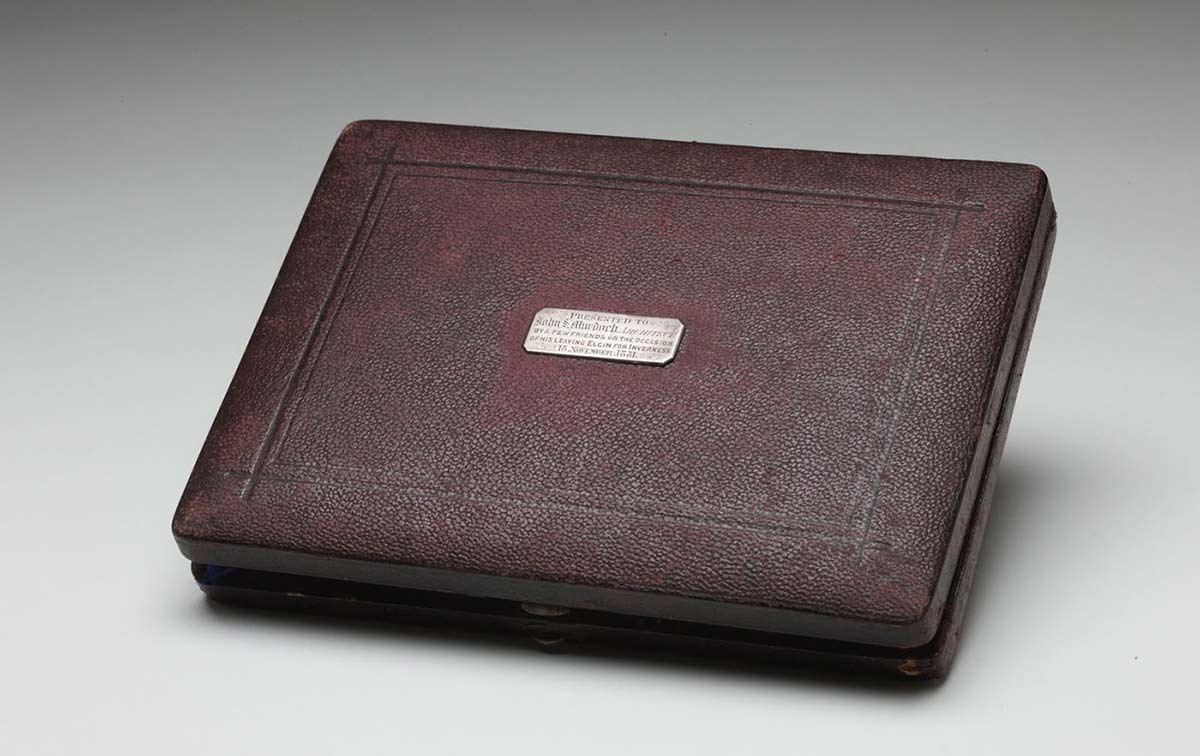This set of drawing instruments was owned by architect John Smith Murdoch, who designed Australia's provisional Parliament House in Canberra. Murdoch chose an unadorned, simple classical style, symmetrical to reflect the two chambers and low-rise in sympathy with the environment.
On the front of the case is a silver plaque engraved with the following: 'Presented to John S Murdoch, Architect / by a few friends on the occasion / of his leaving Elgin for Inverness. 18 November 1881.'
An architect's tools
The case contains 15 individual drawing instruments, which are stored in a moulded tray, lined with blue velvet or velour, and a recessed storage compartment in the lid.
The lid lining is stamped with 'W H Harling, Mathematical Instrument Manufacturer, 40 Hatton Garden, London' and the company's crest.
Many of the instruments were made by W H Harling, as indicated by the stamp. However, some of the instruments were made by J and WE Archbutt, Stanley and Elliot Brothers, suggesting that the case originally contained instruments from a variety of manufacturers or that Murdoch had replaced items over time.
Several instruments, including the protractor, are marked with Murdoch's name or initials.
Murdoch carried this standard set of drawing instruments with him to Australia, where they were later retained by family members.
Architect of the nation's capital
John Smith Murdoch was born in Scotland in 1863. Murdoch trained as an architect with Matthews and Mackenzie, a practice which had offices in Aberdeen and Inverness. The inscription on the lid of the drawing instruments case indicates that Murdoch worked for a time at Inverness.
Murdoch migrated to Australia in 1885 and shortly after was employed by the Queensland Department of Mines and Public Works. In 1901 he was appointed Queensland District Architect and was responsible for designing many of the state's government and public buildings.
In 1904 Murdoch joined the newly formed Commonwealth Department of Home Affairs, rising to the position of Chief Architect in the Department of Works and Railways in 1919. This made him the first Commonwealth Government Chief Architect.
During his career, Murdoch designed more than 120 buildings and public spaces in Australia, including the General Post Office and Forrest Place in Perth, the Spencer Street Post Office and the High Court of Australia (now the Federal Court) in Melbourne, and Anzac Square in Brisbane.
He was a member of the review panel for the National Capital design competition, won by Walter Burley Griffin and Marion Mahony Griffin in 1912. Murdoch also supported an international competition for the design of a parliament house in Canberra, which was eventually abandoned due to ongoing disagreements and the onset of the First World War.

Parliament House
In 1923 Murdoch was given the task of designing a temporary parliament house until a suitable design and sufficient funds could be found for a permanent building.
As the architectural coordinator for all aspects of the building, Murdoch completed drawings for the exterior and interior fittings and furnishings.
Murdoch's stripped classical design for provisional Parliament House reflected his training in Glasgow, earlier work in Australia, and visits to parliamentary buildings in London, Berlin, Paris, Vienna and Washington.
While both functional and economical, the symmetrical structure was symbolic of Australia's democratic bicameral (two legislative chambers) parliament and was sympathetic to Canberra's natural and built environments.
Construction commenced in August 1923, and was completed in 1927 at a cost of £644,600 (three times the original estimate). The building spanned four acres (1.6 hectares), with a total of 184 rooms. It was designed to house the requirements of parliament at the time, though numerous changes were made as parliament expanded in the following decades.
Murdoch contributed to the establishment of Canberra by designing and constructing a number of significant buildings, including the Powerhouse at Kingston, the Hotel Canberra (now the Hyatt Canberra), Hotel Kurrajong, East and West Blocks, and Gorman House.
Murdoch also adjudicated design competitions for the Australian War Memorial in Canberra and the Australian National War Memorial in Villers-Bretonneux, France.
Murdoch retired in 1929, still an active member of the Royal Victorian Institute of Architects. He died in Brighton, Melbourne in 1945.
The provisional Parliament House building was in use until 1988 when a new permanent Parliament House was opened. The building, then known as Old Parliament House, was reopened in 1992 as a museum and exhibition spaces for the National Portrait Gallery and National Museum of Australia.
In 2006 Old Parliament House was included in the National Heritage List, and in 2009 was re-established as the Museum of Australian Democracy at Old Parliament House.
Roger Stuart donated the drawing instruments to the Museum in 2009.
In our collection

